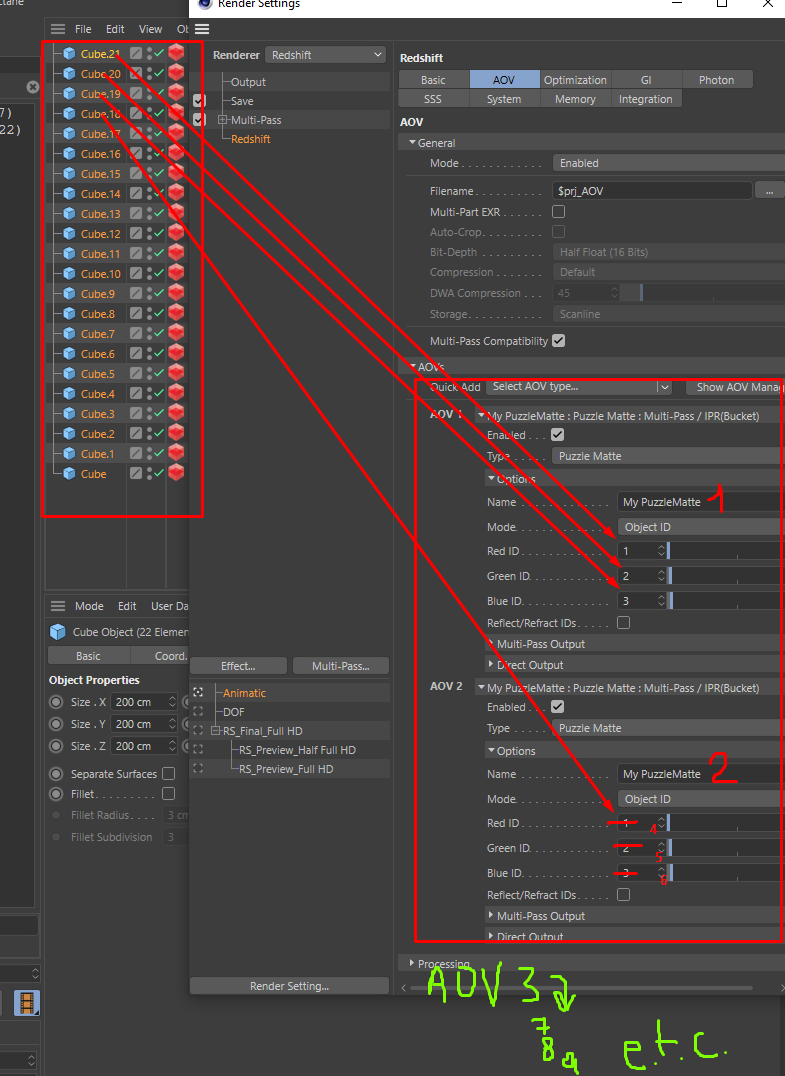How to Add Multiple Redshift Pazzle Matte AOVs
-
Hello, everyone! Im learning python and trying to make useful stuff, but it`s hard to understand some things.
I`m writing now a simple script for Redshift users. The task is:
- Add individual Object ID tags to selected objects (for examle, obj1 = 1, obj2 = 2 , ...)
- Create Redshift Pazzle Matte AOVs (PM)
The trick is to make enough PM to be enough for each object that is selected in the scene.
1 PM AOV is equal to 3 objects in scene. For example I generated 9 Object ID tags. Every tag assign uniqe number for every object (1, 2, 3, ...). For each of them I need PMs where every channel is object in scene.
- How to generate multiple PMs with uniqe names and increasing numbers for my Object IDs?
- How to improve this code?
Thank you for your attention!

import c4d import c4d.documents from c4d import gui import redshift from pprint import pprint def ob_tags(): flags = (c4d.GETACTIVEOBJECTFLAGS_SELECTIONORDER | c4d.GETACTIVEOBJECTFLAGS_CHILDREN) selection = doc.GetActiveObjects(flags) if not selection: c4d.gui.MessageDialog("Please select objects") doc.StartUndo() for i, obId in enumerate(selection): tag = c4d.BaseList2D(1036222) tag[c4d.REDSHIFT_OBJECT_OBJECTID_OVERRIDE] = True tag[c4d.REDSHIFT_OBJECT_OBJECTID_ID] = i+1 obId.InsertTag(tag) doc.AddUndo(c4d.UNDOTYPE_NEW, tag) doc.EndUndo() def CreateAOVs(vpRS): flags = (c4d.GETACTIVEOBJECTFLAGS_SELECTIONORDER | c4d.GETACTIVEOBJECTFLAGS_CHILDREN) selection = doc.GetActiveObjects(flags) # 1 AOV is 3 channels, for 9 objects for example need 3 Pazzle Matte aovs_quantity = int(len(selection) // 3) #to be sure numbers ok in console print('aovs_quantity is ', aovs_quantity ) print('objects in scene ', len(selection)) aovs = redshift.RendererGetAOVs(vpRS) aov = redshift.RSAOV() aov.SetParameter(c4d.REDSHIFT_AOV_TYPE, c4d.REDSHIFT_AOV_TYPE_PUZZLE_MATTE) aov.SetParameter(c4d.REDSHIFT_AOV_ENABLED, True) aov.SetParameter(c4d.REDSHIFT_AOV_NAME, "My PuzzleMatte") aov.SetParameter(c4d.REDSHIFT_AOV_PUZZLE_MATTE_MODE, c4d.REDSHIFT_AOV_PUZZLE_MATTE_MODE_OBJECT_ID) #this is where channels need to assign aov.SetParameter(c4d.REDSHIFT_AOV_PUZZLE_MATTE_RED_ID, 1) aov.SetParameter(c4d.REDSHIFT_AOV_PUZZLE_MATTE_GREEN_ID,2) aov.SetParameter(c4d.REDSHIFT_AOV_PUZZLE_MATTE_BLUE_ID,3) aovs.append(aov) return redshift.RendererSetAOVs(vpRS, aovs) def main(): ob_tags() doc = c4d.documents.GetActiveDocument() renderdata = doc.GetActiveRenderData() flags = (c4d.GETACTIVEOBJECTFLAGS_SELECTIONORDER | c4d.GETACTIVEOBJECTFLAGS_CHILDREN) selection = doc.GetActiveObjects(flags) aovs_quantity = int(len(selection) // 3) # Get the Redshift videoPost and render settings vprs = redshift.FindAddVideoPost(renderdata, redshift.VPrsrenderer) if vprs is None: return # Switch renderer renderdata[c4d.RDATA_RENDERENGINE] = redshift.VPrsrenderer CreateAOVs(vprs) if __name__=='__main__': c4d.CallCommand(13957) c4d.EventAdd() main() -
hi,
if you wants to know how many AOVs you need for 10 objects you should use Ceil. After that, some math to have your ID raising by 1.
numberOfAOVs = math.ceil(10 / 3.0) # will give you 4 for i in xrange(int(numberOfAOVs)): print ("create aov number {}".format(i)) for j in xrange (3): print ("value of field will be : {}".format(j + i * 3 ) )I'm not a big fan of retrieving all the objects on each function. But first, make things works, than optimize. (at least at the beginning)
Cheers,
Manuel -
 I i_mazlov forked this topic on
I i_mazlov forked this topic on
